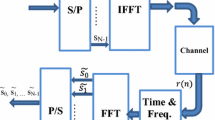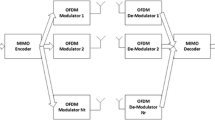Abstract
Due to frequency-selective and time-variant property of wireless channel together with additive noise and mismatch of oscillators between transmitter and receiver, there are always time and frequency synchronization errors in a practical OFDM system. To investigate the effect of the two kinds of errors on system performance, the average normalized interference power (NIP) is defined. A simple supper bound for NIP caused by time synchronization error (TSE) and the tighter upper bound for NIP resulting from frequency synchronization error (FSE) are derived independently. Simulations in typical short wave (SW) and medium wave (MW) channels further verify the correctness and tightness of these upper bounds. They actually provide good approximations to NIPs. Moreover, the upper bound for NIP resulting from FSE is tighter than traditional upper bound. Additionally, a new solution is proposed to relax the precision requirement for time synchronization algorithm, which can achieve a better tradeoff between time synchronization precision and bandwidth efficiency. These upper bounds will be useful in developing and choosing time and frequency synchronization algorithms in OFDM system to achieve a specific NIP value for a given channel condition.
Similar content being viewed by others
References
Chang, R. W., Synthesis of band-limited orthogonal signals for multi-channel data transmission, Bell Syst. Tech. J., 1966, 45(12): 1775–1796.
Chang, R. W., Gibby, R. A., A theoretical study of performance of an orthogonal multiplexing data transmission scheme, IEEE Trans. Commun., 1968, 16(8): 529–540.
Cimini, L. J., Analysis and simulation of a digital mobile channel using orthogonal frequency division multiplexing, IEEE Trans. Commun., 1985, 33(7): 665–675.
Bingham, J. A., Multicarrier modulation for data transmission: an idea whose time has come, IEEE Commun. Mag., 1990, 34(5): 5–14.
Choi, Y. S., Voltz, P. J., Casara, F. A., On channel estimation and detection for multicarrier signals in fast and selective Rayleigh Fading Channels, IEEE Trans. Commun., 2001, 49(8): 1375–1387.
Weinstein, S. B., Ebert, P. M., Data transmission by frequency-division multiplexing using the discrete Fourier transform, IEEE Trans Communication Technology, 1971, 19(10): 628–634.
Molisch, A. F., Wideband Wireless Digital Communication, Beijing: Publishing House of Electronics Industry, 2001, 20–48.
Paulraj, A. J., Gore, D. A., Nabar, R. U., et al., An Overview of MIMO Communications—A Key to Gigabit Wireless, Proceedings of IEEE, 2004, 92(2): 198–216.
Stuber, G. L., Barry, J. R., Mclaughlin S. W. et al., Broadband MIMO-OFDM wireless communications, Proceedings of IEEE, 2004, 92(2): 271–293.
Gesbert, D., Shafim, M., Shiu, D. S., et al., From theory to practice: An overview of MIMO space-time coded wireless systems, IEEE JSAC, 2003, 21(4): 281–298.
Jiang, W., Xiang, H. G., Multiuser detection algorithm based on belief propagation in multiple-input multiple-output systems, Science in China, Ser. F, 2004, 47(4): 384–393.
Athaudage, C. R. N., BER sensitivity of OFDM systems to time synchronization error, The 8th International Conference on Communication Systems (ICCS 2002), 2002, 25–28(1): 42–46.
Gudmundson, M., Anderson, P. O., Adjacent channel interference in an OFDM system, In Vehicular Technology Conference Mobile Technology for the Human Race., IEEE 46th, 1996, 28(2): 918–922.
Moose, P. H., A technique for orthogonal frequency division multiplexing frequency offset correction, IEEE Trans. Communication, 1994, 42(10): 2908–2914.
Speth, M., Fechtel, S. A., Fock, G. et al., Optimum receiver design for wireless broad-band systems using OFDM-Part I, IEEE Trans. Commun., Vol. COM-3, 1999, 47(11): 1668–1677.
Shu, F., Lee, J., Wu, L. N. et al., Time-frequency channel estimation for digital amplitude modulation broadcasting system based on OFDM, IEE Proceedings Communications, 2003, 150(8): 259–264.
Digital Radio Mondiale (DRM) system specification, European Telecommunication Standards Institute (ETSI), ETSI TS 101980, 2001.
Jakes, W. A., Microwave Mobile Communication, New York: Piscataway (IEEE Press), 1993.
Edfors, O., Sandell, M., van de Beek, J. J. et al., OFDM channel estimation singular value decomposition, IEEE Trans. Commun., 1998, 46(7): 931–938.
Huang, Y. L., Sheu, C. R., Huang, C. C., Joint synchronization in Eureka 147 DAB system based on abrupt phase change detection, IEEE JSAC, 1999, 17(10): 1770–1780.
Editing Group of Mathematic Handbook, Mathematic Handbook, Beijing: Publishing House of High-Level Education, 1977.
Author information
Authors and Affiliations
Corresponding author
Rights and permissions
About this article
Cite this article
Shu, F., Cheng, S., Lee, J. et al. Analysis of time and frequency synchronization error for wireless systems using OFDM. Sci China Ser F 48, 379–396 (2005). https://doi.org/10.1360/122004-38
Received:
Published:
Issue Date:
DOI: https://doi.org/10.1360/122004-38




